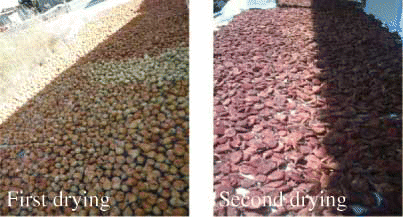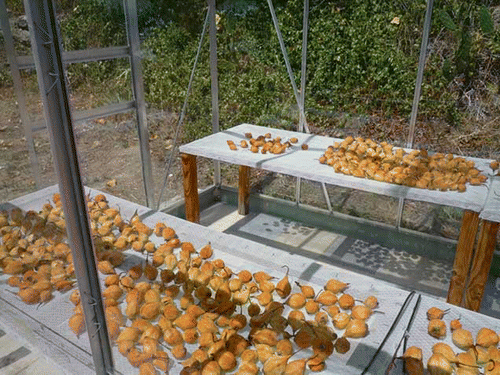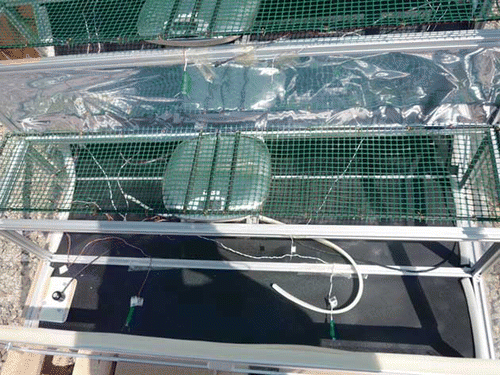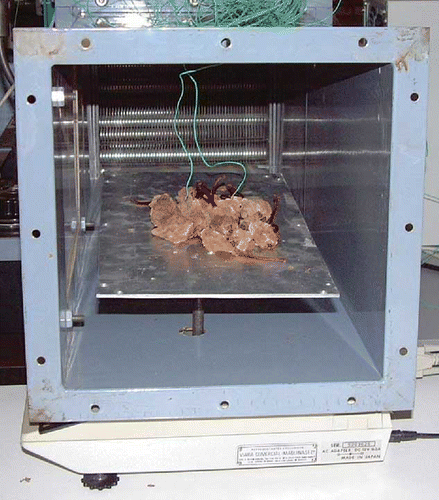Abstract
Different methods for the drying of pears, namely a solar stove, a solar dryer, and a tunnel dryer, were studied. All processes were conducted in three consecutive years to analyze if the behavior of each drying method showed evidence of a similar pattern, along with producing products similar to the traditional pears that are dried using direct sun exposure. The results showed that all methods led to a considerable reduction in drying time as compared to open-sun drying. Indeed, the drying time for the solar stove and the solar dryer showed a reduction of more than 40% while in the drying tunnel this reduction increased to more than 60%. In addition, it was also possible to conclude that the properties of the dried pears obtained by the three processes correspond to dried fruits similar to the traditional dried pears.
INTRODUCTION
Drying fruits allows their preservation by reducing the water content, and thus inhibiting enzymatic modifications and microbial growth. Besides conservation, among the important advantages of drying are the reduction in size and weight, facilitating transport, and reducing storage space as well as avoiding the need for expensive cooling systems. Finally, it increases food diversity, allowing alternative ways of consuming foods (CitationGuiné and Castro, 2003).
Sun-drying of fruits is one of the oldest and cheapest forms of food preservation, although the mechanisms of the process are not entirely understood. The complex chemical and biological reactions that occur during the process with the consequent reduction in water activity will produce new products with peculiar nutritional and organoleptic characteristics.
Solar drying has been used for centuries, but it is restricted to areas with a high solar incidence. In spite of the slowness of the process and the need of much handwork, this is undoubtedly the cheapest of drying methods. However, it has some important disadvantages, like the dependence on natural factors that cannot be controlled, as well as the need for sizeable exposure areas (CitationSousa et al., 1992). The fruits that are traditionally dried are grapes, figs, plums, peaches, and apricots, but more recently apples and pears have gained importance in this area.
The importance of environmental protection and reduction of fossil fuel consumption during the drying process has directed interest towards the application of solar energy for drying of agricultural products. In the recent past, considerable efforts have been made to design and develop several types of solar dryers (CitationTrypathy and Kumar, 2009).
The pear (Pyrus communis) is a typical fruit of temperate zones and is cultivated in Europe, among other regions. Due to its nutritive properties, good taste, and low caloric level, the pear is a well appreciated fruit by consumers. Although pears can be consumed fresh, they are also commonly submitted to processing techniques in the production of syrup and purées for use in nectars, yogurts, and drying (CitationPark et al., 2002).
The tradition in the center of Portugal is to dry the pears of the ‘S. Bartolomeu’ cultivar by open-air sun exposure in the summer, resulting in a small, dried pear that is highly appreciated. This regional sun-dried pear constitutes a good example of a new product, which is very popular in Portugal, especially at Christmas time.
The traditional solar drying method, which is based on an open-air exposure, provokes changes in taste, color, flavor, and texture, which results in a reddish brown pear that loses its pronounced astringency and accumulates distinctive organoleptic characteristics in terms of texture, taste, color, and flavor (CitationFerreira et al., 2008). Additionally, pears constitute a potential source of dietary fiber of around 12% of total dietary fiber (CitationBarroca et al., 2006).
The traditional solar drying is very time consuming, lasting for approximately 10–11 days (CitationGuiné and Castro, 2002). The traditional solar drying consists of leaving the uncut and peeled pears in direct exposure in open fields (5–6 days) followed by a period of 2 days where they are taken out of the sun at the hottest hour of the day and muffled in barrels or baskets. Next, the pears are flattened by a compression on both sides changing their spherical shape to flat form. After this, they are left again placed in direct sun exposure for 2–3 days (CitationGuiné and Castro, 2003). Despite the simplicity of equipment used within this method, the labor that is involved is quite considerable.
This product, obtained through the traditional method, has obvious disadvantages either concerning the drying efficiency or the sanitary quality of the final product (CitationBarroca et al., 2006; CitationKarathanos and Belessiotis, 1997). In the traditional procedure there is a risk of deterioration due to dust and insect infestation. Although this procedure uses the cheapest of energy sources, this process is completely dependent on climatic conditions and there is still a lack of knowledge about the traditional sun-drying practice to allow a better process control and to maintain the dried pears characteristics each year. In addition, the problems related to food safety and with the labor involved have been an incentive to use new processes to dry pears.
Solar crop drying has been demonstrated to be an effective alternative to traditional drying systems, especially in locations with good sunshine during harvest season (CitationPangavhane and Sawhney, 2002). In fact, this method allows the production of dried fruits in less drying time and with higher food safety, since the problems of hygiene are minimized.
With respect to the drying of pears in Portugal, currently the open-air drying method is being replaced by drying in solar stoves, taking advantage of the lack of cost of solar energy. At the same time, such a method allows the production of cleaner dried fruits since the problems associated with the lack of hygiene are minimized. Additionally, there has been an increasing interest in developing industrial or semi-industrial dryers, such as a tunnel dryer, which allow an important reduction in the drying time, while maintaining all the advantages discussed above.
In the present work, pears of the cultivar ‘S. Bartolomeu’ were dried following the traditional method using direct solar exposure and also with alternative systems. These alternatives to the direct sun exposure method consisted mainly in three treatments that were performed in three different institutions: a solar stove built at ESAV (Escola Superior Agrária de Viseu), a solar dryer constructed at ESTV (Escola Superior de Tecnologia de Viseu), and a tunnel dryer, with air heated through a solar collector, that was placed at UC (Universidade de Coimbra). The purpose of the present work was to study these alternatives to traditional air drying and to analyze their effect on the reduction of drying time and on the physical and chemical properties of the dried pears, and to understand which system produces a product most similar to the traditional one. The study was conducted over three consecutive years.
MATERIALS AND METHODS
Drying Methodologies
Pears of the ‘S. Bartolomeu’ cultivar were purchased from a farmer who produces pears by the traditional method. They were harvested in August, at a ripening stage previously defined by other studies (CitationGuiné et al., 2009). The ripening of the fruits was monitored by moisture, acidity, total soluble solids (TSS), and hardness.
After harvesting, the pears were peeled and dried uncut by the traditional method and also by the three alternative systems tested:
-
Traditional: The traditional open-air sun drying, in which the fruits are left at the sun in the open field (), over nets or straw in the first drying stage and over sheets in the second drying stage;
-
ESAV solar stove: A solar stove/greenhouse made of aluminum with glass (). The stove is a structure of aluminum completely enclosed in 3-mm greenhouse glass with the dimensions: length = 3.2 m, width = 1.9 m, height = 2 m in the center and 1.3 m at the sides. The stove had a ventilator, which was operated in the present experiments at the maximum rotating speed of 1,700 r.p.m., corresponding to the extraction of 900 m3/h of air (CitationGuiné et al., 2007). The system was equipped a thremohygrometer to measure the temperature and relative humidity every 10 min with a recording of medium values at hourly intervals. The pears were placed inside the solar stove over nylon nets, in wood structures.
-
ESTV solar dryer: A solar dryer developed specifically for the drying of pears was made of glass with different levels designed for a more efficient use of the solar energy (). The solar dryer promoted the natural ventilation from an opening in the bottom to another opening in the top. The system was equipped with various thermocouples, anemometers, and other online data acquisition systems, including mass and solar radiation.
-
UC drying tunnel: A drying tunnel () with air heated by a solar collector. The tunnel dryer has a net dimension of 40 × 60 cm and is equipped with two trays of polyethylene and a scale to continuously measure the weight of the batch of pears. The air is heated by an efficient design of a low-cost solar collector, the temperature was kept constant in the range 40–42°C, and the drying air velocity was always 1.1 m/s.
Periodically, different samples from each drying process were taken randomly to analyze their properties. The process was finished when the final water content of the pears reached approximately 20% (wet basis), since this is a value that allows good preservation characteristics (CitationGuiné and Castro, 2003). After drying, the pears were stored in plastic bags and refrigerated at 4°C.
Chemical Analyses
Moisture content was quantified with a Halogen Moisture Analyzer, model HG53 (Mettler Toledo, OH, USA). Total soluble solids and acidity were estimated according to previous established methodologies (CitationAOAC, 1990). The hardness of the pears was determined by a pressure tester with an 8-mm diameter tip. The pear dimensions were determined with a caliper and ruler, and pear mass was determined with an analytical scale.
RESULTS AND DISCUSSION
The results presented in this work refer to three consecutive study years. The general appearance of the pears after the first drying in the traditional process is depicted in . As it can be seen, the appearance of the pears changes very much, especially in color, and apart from these modifications it is expected that there are also some important chemical alterations.
FIGURE 5 Pears after the first drying stage (left) and at the beginning of drying (right) in the traditional drying method. (Figure is provided in color online.)
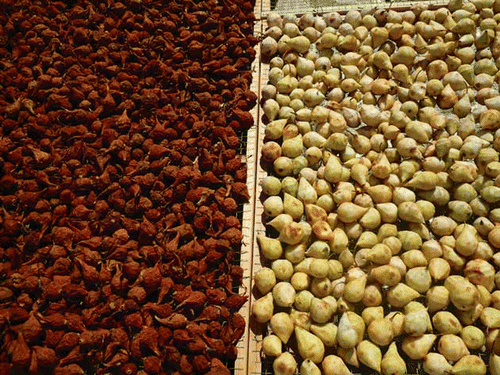
In the first year of study (year N), the pears were harvested at three different dates: one week before the date predicted for harvest by the producer of the traditional dried pears (1st harvest); in the same day that the traditional producer harvested the pears (2nd harvest), this date was considered as the optimum moment for harvest by the producer, although only empirically, since no maturation control is done in the orchard; and one week after the traditional harvest (3rd harvest). The size of the fresh pears presents some variability and, therefore, the pears under study were selected to have a medium diameter of approximately 4–5 cm and a mass in the range of 40–60 g.
The variation of moisture during the drying for these pears (from the three harvest dates), when dried in the ESAV solar stove, is presented in . It can be seen that the more unripe pears (1st harvest) dried faster than the other two, which present a more similar behavior.
FIGURE 6 Variation of the moisture content during drying in the ESAV solar stove, in the first year of study, for three different harvest dates. (Figure is provided in color online.)

a represents the change in acidity for the same drying experiment and the results reveal that once again the first harvest is the one which presents the most different trend, with a fast decrease. This is due to the very high acidity values of the fresh pears, owing to the fact that these pears were in quite an unripe state.
FIGURE 7 Variation of acidity (a) and total soluble solids (b) during drying in the ESAV solar stove, in the first year of study, for three different harvest dates. (Figure is provided in color online.)
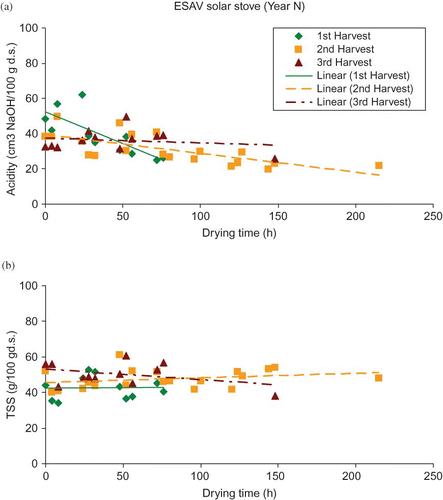
The sugars varied during drying, and were expressed as the total soluble solids content. b shows that no significant differences were encountered between the different pears harvested at different dates.
shows for the first year of study the variations in some properties (hardness, acidity, moisture, total soluble solids, and mass) from the fresh state to the dried state, for the drying carried out in the solar stove at ESAV. The graph in shows that drying induces an important reduction in hardness, acidity, moisture, and mass. However, the total soluble solids content does not change much with drying, thus indicating that the sugars were not notably affected in this case. This conclusion was also evident when analyzing . Furthermore, the differences between the three harvests were not significant in relation to any of the properties evaluated.
FIGURE 8 Variation in the properties for pears of the three harvest dates, dried in the ESAV solar stove. (Figure is provided in color online.)
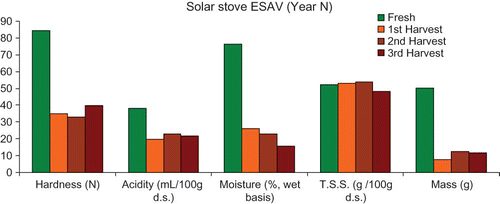
presents the profile of moisture (wet basis) of the pears during drying in the solar stove, solar dryer, and tunnel drying. The results show that the methods of drying under solar radiation (solar stove and solar dryer) do not follow such a linear trend as the drying on the tunnel, with controlled conditions of temperature and air velocity. In fact, the evolution of moisture of the pears dried under incident solar radiation can be related to the changes of climatic conditions during drying. The larger dimensions of the solar stove, when compared with the solar dryer, can also lead to more pronounced variations in the moisture of pears during drying.
FIGURE 9 Evolution of moisture for the drying in three different systems in the second year of study. (Figure is provided in color online.)
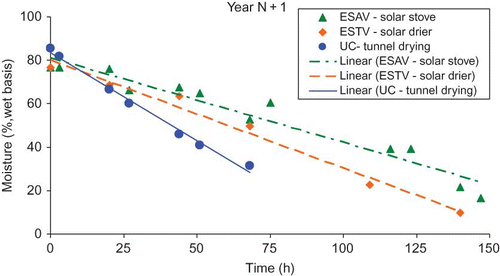
The methods with direct incidence of sun on glass allow a decrease in drying time of more than 40% relative to traditional drying, allowing the drying of the pears in about 6 days. The drying time of open sun drying is of approximately 10–12 days. On the other hand, in the tunnel dryer that decrease is of more than 60%, giving a drying time of only 4 days. The faster drying of the pears inside the tunnel is due to the fact that the temperature is maintained constant at 40°C during drying, while the temperature inside the solar stove or with solar drying is dependent on the hour of the day, and temperatures higher 40°C are reached only for a few hours of the day.
shows how the relation TSS and acidity change during drying in the three drying systems. Both TSS and acidity present some variability during drying, which is a result of the heterogeneity in the fresh pears, as is typical in agricultural commodities. The acidity decreases during drying, with a much more pronounced trend for the tunnel dryer, owing to the shorter drying time. As to TSS, the values practically do not change with drying for the two solar drying systems, whereas for the drying tunnel it decreases.
FIGURE 10 Total soluble solids (a) and acidity (b) variations during drying for three drying systems in the second year of study. (Figure is provided in color online.)
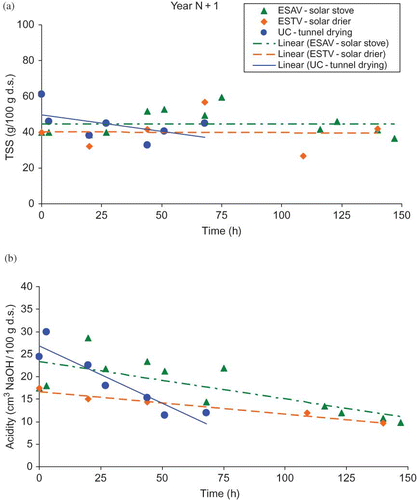
The normalized drying curves (wet basis) of pears in the ESAV solar stove and the UC tunnel drying processes are presented in . A linear relationship was observed between the variation of moisture of the pears during drying in the solar stove in the two consecutive years of drying. The slope of the straight lines is −0.004 and −0.005, respectively, during the first and second years. Furthermore, the time to reach a final moisture content of 20% was about 147 hr for both years.
FIGURE 11 Moisture profile during the drying of pears in the ESAV solar stove (a) and in the UC tunnel dryer (b) in the two first years of study. (Figure is provided in color online.)
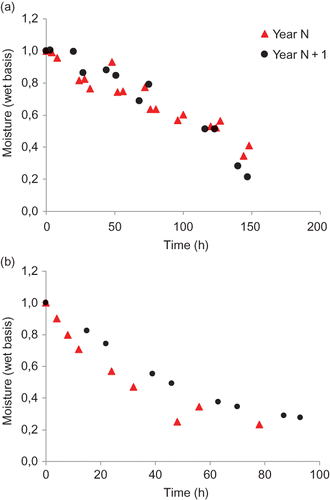
The moisture of pears during the tunnel drying follows an exponential decay and the drying time was found to be around 78 and 93 hr, respectively, in the first and second years. The results for this drying process reveal a faster decrease in moisture and, consequently, a faster drying to reach the same final moisture content. This higher drying rate inside the tunnel is due to the fact that the air is heated by a solar collector and the temperature is controlled at around 40°C inside the system. The pears dried in the solar stove received energy from incident radiation and, therefore, the temperatures of drying are dependent of the climatic conditions and of the hour of the day, since the higher temperatures are reached only a few hours per day.
Regardless of the process, the acidity and the total soluble solids decrease during drying and the variation in the relation TSS/acidity is shown in for both, the ESAV solar stove and the UC drying tunnel. Comparing this ratio for the two dryings in the solar stove in the two years, it is possible to observe a similar behavior during drying. Despite the dispersion of data obtained with the drying tunnel, the ratio also increases with drying time. However, the decrease in acidity of the pears in the solar stove is more pronounced than the TSS and, consequently, a higher ratio of TSS/acidity is observed during the solar stove drying as compared with the tunnel drying.
FIGURE 12 Variation of the ratio TSS/acidity during the drying of pears in the ESAV solar stove (a) and in the UC tunnel dryer (b) in the two first years of study. (Figure is provided in color online.)
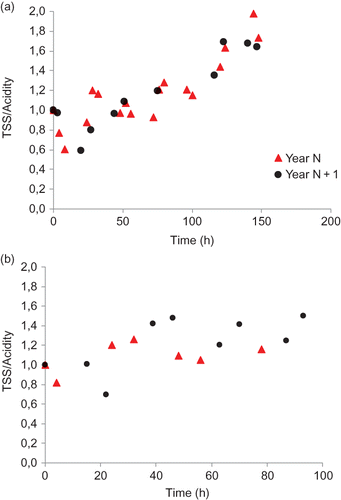
shows some chemical attributes (moisture, acidity, and TSS) for the dried pears obtained with the three different methodologies of drying (the ESAV solar stove, the ESTV solar dryer, and the UC tunnel), as compared to the pears produced by the traditional drying process.
FIGURE 13 Moisture, acidity, and total soluble solids of pears dried by open sun drying, solar stove, solar drying, and tunnel drying. (Figure is provided in color online.)
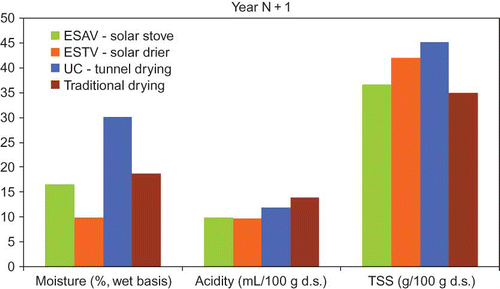
It can be seen that the tunnel drying produced pears with a much higher water content, but also with a higher sugar content, when compared to the traditional drying. With respect to these two properties, the system that led to production of pears more similar to the traditional ones was the ESAV solar stove. Regarding acidity, no significant differences were encountered between all the systems tested. The results obtained enabled to conclude that pears dried by the three alternative methods studied have a chemical composition comparable to those of the traditional open sun drying, thus constituting a good alternative, particularly the ESAV solar stove.
Due to the non homogeneous size of the fresh pears, in year N+1 the pears dried by the traditional method were divided in two sets, according to the size range. Set 1 (small) corresponds to pears with mass and size similar to those obtained with the drying processes under study and the traditional one, whereas set 2 (large) are pears with higher values of size and mass. Pears from these two sets were dried by the traditional method and also in the ESTV solar dryer. The properties of each lot were analyzed, and the results are shown in .
FIGURE 14 Differences between the properties of pears in different size ranges, dried by two different methods. (Figure is provided in color online.)
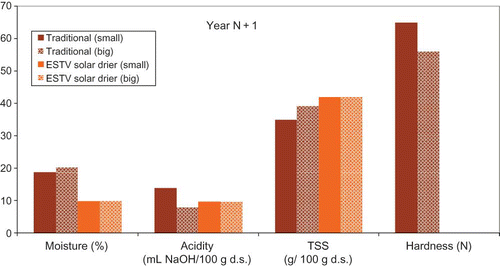
The results highlight that contrary to what would be at first expected, the moisture content does not vary with pear size, thus indicating that the moisture transfer is efficient regardless of the size of the fruit. However, the solar dryer induces a higher degree of dehydration when compared to the traditional method, since the effectiveness in concentration of solar energy is quite higher in this system. Furthermore, the solar dryer allows a similar loss of volatile components in both types of pears, as well as the TSS content. As to the traditional drying method, it allows obtaining less acid and sweeter pears, when they are bigger.
show for the last year of study the variations in some properties of the pears during the drying process for different systems.
FIGURE 15 Variation of moisture during drying for different systems in the last year. (Figure is provided in color online.)
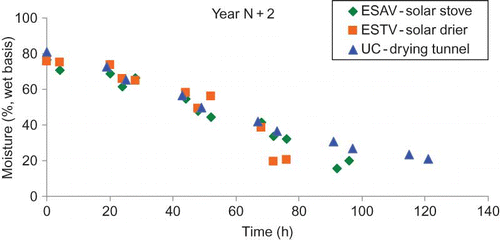
FIGURE 16 Variation of pear mass (a) and dimensions (b) during drying for different systems in the last year. (Figure is provided in color online.)
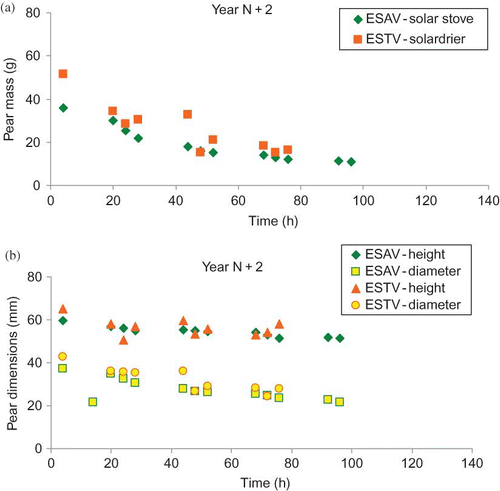
FIGURE 17 Variation of acidity (a) and total soluble solids (b) during drying for different systems in the last year. (Figure is provided in color online.)
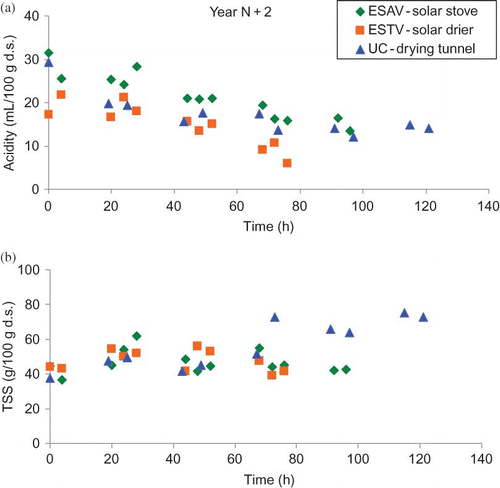
shows the evolution in moisture during drying in the year N+1 for the pears dried in the ESAV solar stove, the ESTV solar dryer, and the UC drying tunnel. It can be seen that for these three drying methodologies the loss of water was approximately similar in the earlier stages of drying, until 70 hr. However, after this time the solar dryer led to lower values of moisture more rapidly, followed by the ESAV solar dryer. The drying tunnel was the system that needed more than 100 hr to reach the end of drying (reaching the same moisture content of about 20%). In the drying process, the pears lost 75% of their initial water, thus reducing the moisture content from 80% to 20% at the end.
a shows the variation in pear mass during drying for the two solar drying systems: ESAV solar stove and ESTV solar dryer. It can be seen from the graph that despite being smaller the pears in ESAV reached approximately the same size as the pears in ESTV after 70 hr of drying. This was because at this drying time the pears in the ESAV system had almost 40% moisture, whereas the pears in ESTV had dried already to 20% moisture content, thus leading to more water loss. The graph in b shows the height and diameter of the pears dried in the solar dryer and solar stove systems. As depicted in the graph, no relevant differences were encountered either in relation to height or diameter between both systems. The diameter in the ESAV stove is slightly smaller than in the ESTV system, because the pears were at the start smaller. As to the variation during drying, it can bee seen that the height suffers a reduction of around 20% and the diameter suffers a reduction of about 45%, when compared to the original values.
a represets the variations in acidity during drying for both solar drying systems (ESAV stove and ESTV dryer) and also for the UC drying tunnel. The results show a reduction in acidity of 63% in the ESTV solar dryer, 57% in the ESAV solar stove, and 53% in the UC drying tunnel. These results are expected, since the temperature in the drying tunnel never exceeded 42°C, whereas in the solar systems, the temperatures in the hottest hours of the day could be higher than 60°C. Furthermore, the ESTV solar dryer is more efficient in concentrating the heat than the ESAV solar stove, thus inducing a higher loss of volatile acids. The graph in b shows the variation of total soluble solids (TSS) during drying, for the three alternative drying systems tested. In the first 70 hr of drying, no significant differences were encountered in the different systems. However, after this time, the TSS contents for the drying tunnel were much higher than those found for the other two drying methodologies. Furthermore, after this point, the TSS content increases in the UC drying tunnel, whereas it decreases in the other two solar systems. This results in dried pears that are sugar richer in the drying tunnel, as compared to the solar systems. This is due to deterioration reactions, such as Maillard reactions, which occur to a further extent in the solar systems, due to the higher temperatures registered in these dryings.
When comparing the properties: moisture, acidity, and TSS for the three consecutive years of study (), it can be seen that in the last year of the study (year N+2) the dried pears were sweeter than in year N+1 for all systems. With respect to acidity, and comparing the same years, the pears were more acidic in ESAV and UC and less acidic for ESTV. However, these differences are very slight, and the general overview is that the results of the three years of study did not differ much.
CONCLUSIONS
The traditional drying method for obtaining this kind of pear product is too slow and requires too much labor, and also presents serious problems related to safety and food quality. Other methodologies were tested, having in mind the possible replacement of the old techniques with more modern ones.
Consequently, pears were dried at the same time in a solar stove, solar dryer, and a drying tunnel, and the efficiency of drying and the chemical composition of the final product was compared with the traditional fruit dried by the direct sun-drying exposure method.
The results indicated that the drying time was reduced to more than 40% in the solar stove and solar dryer and more than 60% in the tunnel drying as compared with traditional open-air sun drying.
The profile of TSS/acidity ratio presents some variability during drying in the three methods and the dried pears obtained using the solar stove and solar dryer present a higher value of total soluble solids/acidity ratio. This can be due to the longer drying time in these methods, when compared with the tunnel dryer. In addition, all three drying processes maintained the chemical characteristics in the dried pears similar to those of the traditional pears and potentially produced safer foods. Thus, the results obtained during a three-year period of study reveal that the alternative drying systems tested (drying tunnel, solar stove, and solar dryer) produced products that are very much alike, with the two solar systems being very similar. Furthermore, the results obtained show that the three different drying methods do not produce fruits much different than those dried by the traditional method. Therefore, these results indicate that the systems studied, and particularly the two solar systems, are apparently viable alternatives to the traditional solar drying.
ACKNOWLEDGMENTS
The authors thank FCT for its financial support (Project PTDC/AGR-ALI/74587/2006).
LITERATURE CITED
- Association of Official Analytical Chemists (AOAC) . 1990 . Official methods of analysis , 15th , Arlington, VA : AOAC .
- Barroca , M.J. , Guiné , R.P.F. , Pinto , A. , Gonçalves , F.M. and Ferreira , D.M.S. 2006 . Chemical and microbiological characterization of Portuguese varieties of pears . Food and Bioproducts Proc. , 84 ( C2 ) : 109 – 113 .
- Ferreira , D. , Lopes , J.A. , da Silva , G. , Pinto , C. , Santos , I. Delgadillo and Coimbra , M.A. 2008 . Effect of sun-drying on microstructure and texture of S. Bartolomeu pears (Pyrus communis L.) . European Food Res.Technol. , 226 ( 6 ) : 1545 – 1552 .
- Guiné , R. , Lopes , P. , Barroca , M.J. and Ferreira , D.M.S. 2009 . Effect of ripening stage on the solar drying kinetics and properties of S. Bartolomeu Pears (Pyrus communis L.) . Intl. J. Academic Res. , 1 ( 1 ) : 46 – 52 .
- Guine , R.P.F. and Castro , J.A.A.M. 2002 . Pear drying process analysis: Drying rates and evolution of water and sugar concentrations in space and time . Drying Technol. , 20 ( 7 ) : 1515 – 1526 .
- Guiné , R.P.F. and Castro , J.A.A.M. 2003 . Analysis of moisture content and density of pears during drying . Drying Technol. , 21 ( 3 ) : 581 – 591 .
- Guiné , R.P.F. , Ferreira , D.M.S. , Barroca , M.J. and Gonçalves , F.M. 2007 . Study of the drying kinetics of solar-dried pears . Biosystems Eng. , 98 ( 4 ) : 422 – 429 .
- Karathanos , V.T. and Belessiotis , V.G. 1997 . Sun and artificial air drying kinetics of some agricultural products . J. Food Eng. , 31 ( 1 ) : 35 – 46 .
- Pangavhane , D.R. and Sawhney , R.L. 2002 . Review of research and development work on solar dryers for grape drying . Energy Conversion and Mgt. , 43 ( 1 ) : 45 – 61 .
- Park , K.J. , Bin , A. , Brod , F.P.R. and Park , T.H.K.B. 2002 . Osmotic dehydration kinetics of pear D'anjou (Pyrus communis L.) . J. Food Eng. , 52 ( 3 ) : 293 – 298 .
- Sousa , I. , Braz , N. and Pereira , H. Fig drying. Traditional method and solar chamber . Proc. 1st Mtg. on Agro-Industries . Lisbon, Portugal. pp. 205 – 210 .
- Tripathy , P.P. and Kumar , S. 2009 . A methodology for determination of temperature dependent mass transfer coefficients from drying kinetics: Application to solar drying . J. Food Eng. , 90 : 212 – 218 .
